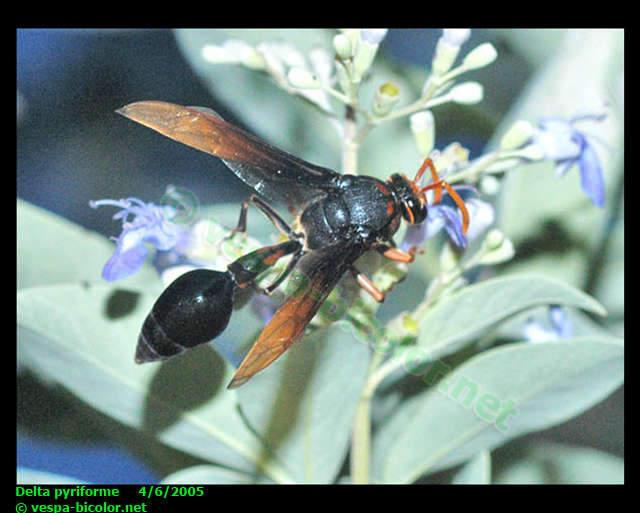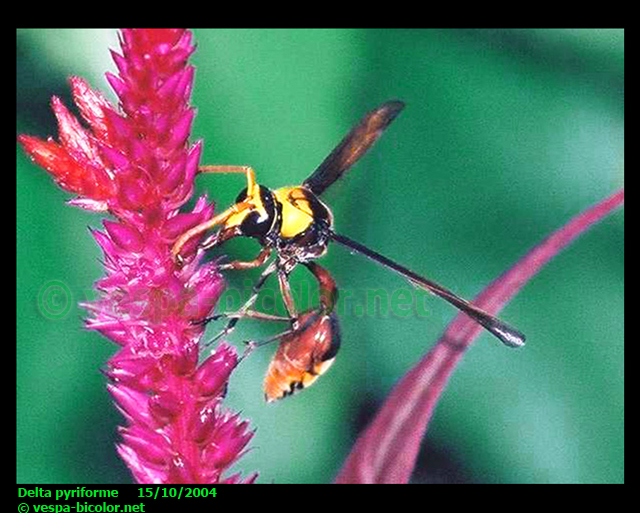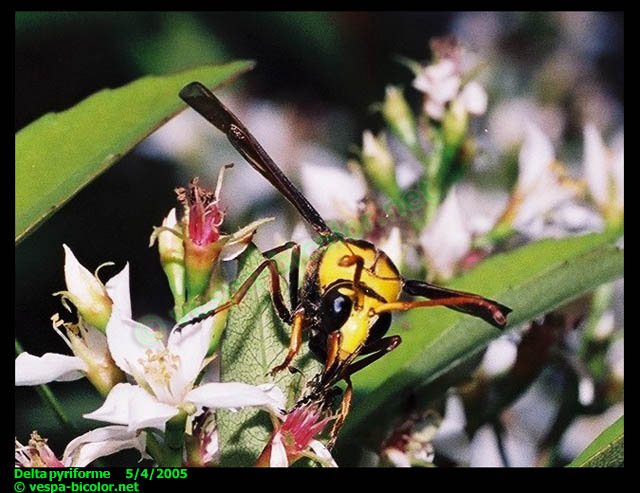
This is a large and impressive potter wasp, usually 20 to 25mm, though capable of reaching at least 30mm; males are smaller and thinner. The colour form found in Hong Kong is brilliantly marked with yellow, brown and black. The yellow colouring forms a distinctive pattern on the thorax; this, along with its large size, serves to differentiate it from similar species such as Delta campaniforme or Delta esuriens.
The colour form found in Singapore and other parts of Southeast Asia looks completely different. It is a very dark brown (almost black; the brown does not show up on camera if the photo was taken with flash), with brown legs, very small reddish markings on the front of the thorax and the petiole (the long "waist" which comprises the first abdominal segment) and a lighter brown head and antennae.
This species is sometimes known under the synonyms of Delta petiolata or Eumenes pyriformis. It is quite widely distributed; besides Hong Kong, its range includes Myanmar, India, Taiwan and Mainland China, Singapore, Malaysia and Indonesia and probably other parts of Southeast Asia.
This is a very common species in both Singapore and Hong Kong. It is well-adapted to life near human dwellings and can be found in all habitats, both urban and natural. In Hong Kong, it is sometimes active even through the colder part of winter. It uses a variety of nesting sites, often on tree trunks and branches, and also frequently on man-made structures. The nest starts out as one typically "pot-shaped" cell. However, each individual female will add new pot-shaped cells to the nest, then eventually cover them with mud, so that it becomes one solid mass and the invidual pots are no longer seen. Each nest may have 5-10 cells when completed, though I have seen some extraordinarily large ones with more.
When not building their nests, females can be seen searching through vegetation for their prey, large non-hairy moth caterpillars, and both males and females are often found feeding on nectar from flowers of various plants, including many ornamental species, and are thus often seen in gardens.
The two colour forms of this species look so different that I formerly thought them to be two different species. I was able to identify the form found in Hong Kong easily (though I made the same mistake of labelling it "Delta petiolata" as many others have), but was unable to identify the form found in Singapore and neighbouring regions till I finally came across the appropriate references which contained keys to Delta species of the region. Apart from the sharp contrast in colour, I have observed that this species displays identical behaviour in all aspects in both Singapore and Hong Kong.
Because of its large size, it often attracts considerable attention and also causes consternation. Despite its menacing appearance, it is totally harmless and has a surprisingly mild sting, and will not attack anyway. If you happen to catch sight of one and see it in the process of building its nest, I suggest you watch this fascinating process. Just don't get too close, not for fear of being attacked but to prevent scaring it away!
Below: An individual of the Singapore colour form feeding on nectar from flowers.

Below: The colour form found in Hong Kong.

